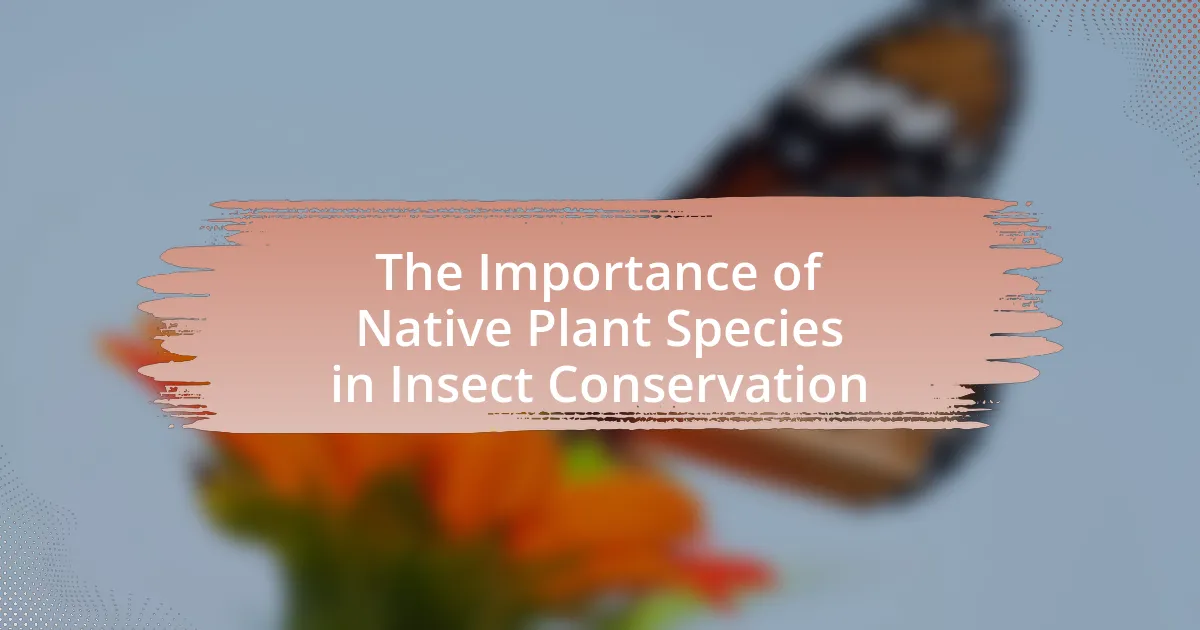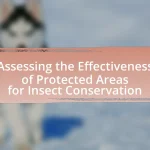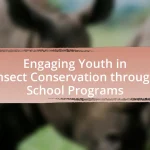Native plant species are essential for insect conservation, providing critical habitats and food sources that support diverse insect populations. Research shows that landscapes dominated by native plants can sustain significantly higher insect diversity and abundance compared to those with non-native species. The article explores the specific benefits of native plants for insects, their role in promoting biodiversity, and the challenges they face due to habitat loss and invasive species. It also discusses strategies for promoting native plant use in conservation efforts, including community engagement and educational initiatives, highlighting the importance of public awareness in supporting native plant conservation.
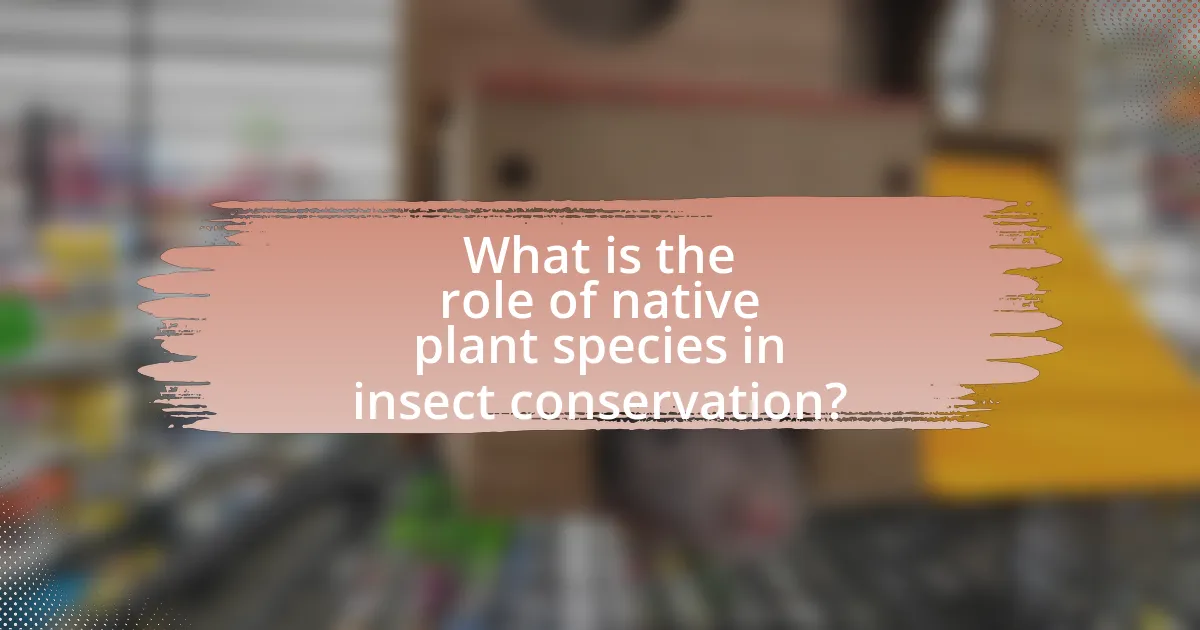
What is the role of native plant species in insect conservation?
Native plant species play a crucial role in insect conservation by providing essential habitats and food sources for various insect populations. These plants support local ecosystems by offering nectar, pollen, and foliage that are vital for the survival of pollinators and other beneficial insects. Research indicates that landscapes dominated by native plants can sustain higher insect diversity and abundance compared to those with non-native species. For instance, a study published in the journal “Ecological Applications” by Tallamy et al. (2017) found that native plants support 29 times more caterpillar species than non-native plants, which are critical food sources for birds and other wildlife. This relationship underscores the importance of native plant species in maintaining healthy insect populations and, consequently, the overall biodiversity of ecosystems.
Why are native plants crucial for insect populations?
Native plants are crucial for insect populations because they provide essential food sources and habitat that support biodiversity. Many insects, including pollinators like bees and butterflies, have evolved to rely on specific native plants for nectar and pollen. Research indicates that landscapes dominated by native flora can support up to 50% more insect species compared to those with non-native plants. This is due to the co-evolution of native plants and insects, which fosters specialized relationships that enhance survival and reproduction rates among insect populations.
What specific benefits do native plants provide to insects?
Native plants provide essential benefits to insects by serving as primary food sources and habitats. These plants offer nectar and pollen that are crucial for the survival and reproduction of various insect species, particularly pollinators like bees and butterflies. Research indicates that native flowering plants support higher populations of pollinators compared to non-native species, as they have co-evolved with local insects, providing the specific nutrients and resources that these insects require. For example, a study published in the journal “Ecological Applications” found that landscapes dominated by native plants can support up to 50% more pollinator species than those with predominantly non-native flora. This relationship underscores the critical role of native plants in maintaining healthy insect populations and promoting biodiversity.
How do native plants support biodiversity among insects?
Native plants support biodiversity among insects by providing essential food sources and habitats that are specifically adapted to local ecosystems. These plants offer nectar, pollen, and foliage that cater to the dietary needs of various insect species, including pollinators like bees and butterflies. Research indicates that landscapes dominated by native flora can support up to 50% more insect species compared to non-native plant landscapes, as native plants are more likely to host the specific herbivores and predators that form complex food webs. This interaction enhances ecosystem resilience and stability, demonstrating the critical role of native plants in maintaining insect biodiversity.
How do native plant species interact with local ecosystems?
Native plant species interact with local ecosystems by providing essential habitat and food sources for various organisms, particularly insects. These plants support local biodiversity by offering nectar, pollen, and shelter, which are crucial for the survival of pollinators and other wildlife. For example, studies have shown that native flowering plants can increase the abundance and diversity of pollinator species, such as bees and butterflies, by up to 50% compared to non-native species. This interaction enhances ecosystem resilience and stability, as native plants are adapted to local soil, climate, and wildlife, thereby promoting a balanced ecological network.
What is the relationship between native plants and insect food sources?
Native plants serve as essential food sources for insects, providing nectar, pollen, and foliage that support their life cycles. Research indicates that native plants are more effective at attracting and sustaining local insect populations compared to non-native species, as they have co-evolved with these insects, offering the specific nutrients and habitat they require. For example, a study published in the journal “Ecological Applications” by Tallamy and Shropshire (2009) found that landscapes dominated by native plants supported significantly higher numbers of caterpillars, which are crucial food sources for birds and other wildlife. This relationship underscores the critical role of native plants in maintaining healthy insect populations and, consequently, broader ecosystem health.
How do native plants influence insect habitat availability?
Native plants significantly enhance insect habitat availability by providing essential resources such as food, shelter, and breeding sites. These plants support a diverse range of insects, including pollinators like bees and butterflies, by offering nectar and pollen. Research indicates that landscapes dominated by native flora can sustain up to 50% more insect species compared to those with non-native plants, as native species are better adapted to local ecosystems and provide the specific conditions insects require for survival. Furthermore, native plants contribute to the overall health of ecosystems by fostering complex food webs, which are crucial for maintaining insect populations.
What challenges do native plant species face in conservation efforts?
Native plant species face significant challenges in conservation efforts, primarily due to habitat loss, invasive species, and climate change. Habitat loss, driven by urban development and agriculture, reduces the available space for these plants to thrive, leading to population declines. Invasive species often outcompete native plants for resources, disrupting local ecosystems and diminishing biodiversity. Climate change further exacerbates these issues by altering temperature and precipitation patterns, which can affect the growth and survival of native species. According to the U.S. Fish and Wildlife Service, habitat loss is one of the leading causes of species extinction, highlighting the urgency of addressing these challenges in conservation strategies.
What are the impacts of invasive species on native plants and insects?
Invasive species negatively impact native plants and insects by outcompeting them for resources, disrupting ecosystems, and altering habitat structures. For instance, invasive plants often grow faster and reproduce more quickly than native species, leading to a decline in biodiversity. This decline can result in reduced food sources and habitat for native insects, which rely on specific plants for survival. A study published in the journal “Ecological Applications” found that invasive species can reduce native plant diversity by up to 50%, which directly affects the insects that depend on those plants for food and shelter.
How does urbanization affect native plant populations and insect diversity?
Urbanization negatively impacts native plant populations and insect diversity by altering habitats and introducing non-native species. As urban areas expand, natural landscapes are replaced with impervious surfaces, reducing the availability of native plants that provide essential resources for local insects. Research indicates that urban environments often support fewer native plant species, which in turn leads to a decline in insect populations that rely on these plants for food and habitat. For example, a study published in “Ecological Applications” by McKinney (2002) found that urbanization can decrease insect diversity by up to 50% in heavily developed areas compared to natural habitats. This loss of native flora and fauna disrupts ecological interactions, further diminishing biodiversity and ecosystem health.
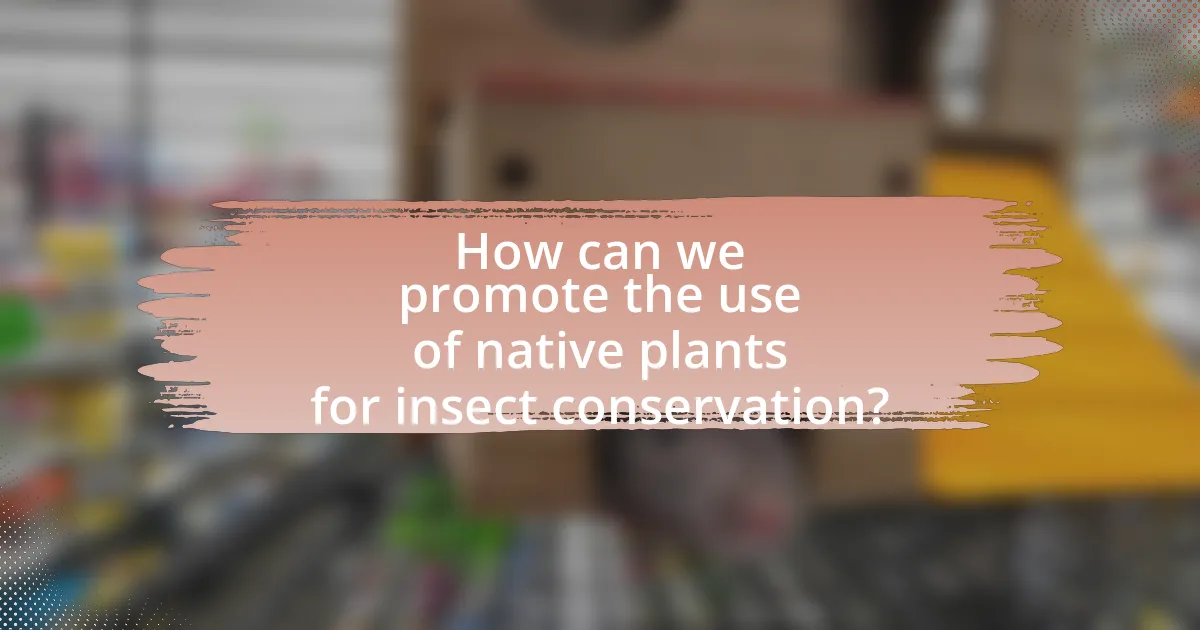
How can we promote the use of native plants for insect conservation?
Promoting the use of native plants for insect conservation can be achieved through education, community engagement, and policy support. Educational programs can inform the public about the ecological benefits of native plants, such as their role in supporting local insect populations, which are crucial for pollination and ecosystem health. Community engagement initiatives, like native plant gardens and workshops, can encourage residents to incorporate native species into their landscapes. Additionally, advocating for policies that prioritize native plant use in public landscaping and restoration projects can create broader support for their conservation. Research indicates that native plants support 50% more species of butterflies and moths compared to non-native plants, highlighting their importance in maintaining insect biodiversity.
What strategies can be implemented to encourage native plant growth?
To encourage native plant growth, strategies such as selecting appropriate native species, implementing proper soil management, and utilizing natural pest control methods can be effectively employed. Selecting native species ensures that plants are well-adapted to the local environment, which enhances their growth and resilience. Proper soil management, including testing soil pH and nutrient levels, supports healthy plant development by providing the necessary conditions for growth. Additionally, utilizing natural pest control methods, such as introducing beneficial insects, reduces the need for chemical pesticides, which can harm native plants and their ecosystems. These strategies collectively promote a thriving environment for native plants, which are crucial for supporting local insect populations and maintaining biodiversity.
How can community gardens support native plant species?
Community gardens can support native plant species by providing a dedicated space for their cultivation and promoting biodiversity. These gardens often include a variety of native plants that attract local pollinators and other beneficial insects, which are essential for ecosystem health. Research indicates that native plants are more effective at supporting local wildlife compared to non-native species, as they have co-evolved with local insects and provide the necessary food sources and habitat. For example, a study published in the journal “Ecological Applications” found that gardens with a higher diversity of native plants significantly increased the abundance of native bee populations. By fostering native plant growth, community gardens contribute to the conservation of local insect species and enhance overall ecological resilience.
What role do educational programs play in promoting native plants?
Educational programs play a crucial role in promoting native plants by increasing public awareness and understanding of their ecological benefits. These programs educate individuals about the importance of native plants in supporting local ecosystems, particularly in providing habitat and food sources for native insects, which are vital for pollination and biodiversity. Research indicates that communities engaged in educational initiatives are more likely to participate in conservation efforts, such as planting native species in gardens and public spaces, thereby enhancing local biodiversity and ecosystem resilience.
Why is public awareness important for native plant conservation?
Public awareness is crucial for native plant conservation because it fosters understanding and appreciation of the ecological roles these plants play, particularly in supporting insect populations. Increased public knowledge leads to greater community involvement in conservation efforts, which is essential since native plants provide habitat and food for many insect species, including pollinators. Research indicates that areas with higher public engagement in conservation activities see improved biodiversity outcomes, as community members are more likely to participate in restoration projects and advocate for policies that protect native habitats.
How can social media campaigns raise awareness about native plants?
Social media campaigns can raise awareness about native plants by utilizing engaging content, targeted messaging, and community involvement. These campaigns often share visually appealing images and informative posts that highlight the ecological benefits of native plants, such as supporting local insect populations and enhancing biodiversity. For instance, studies have shown that native plants provide essential habitats and food sources for pollinators, which are crucial for ecosystem health. By leveraging platforms like Instagram and Facebook, organizations can reach a broader audience, encouraging individuals to participate in local conservation efforts and plant native species in their gardens. This approach not only educates the public but also fosters a sense of community around the importance of preserving native flora for insect conservation.
What are effective ways to engage local communities in conservation efforts?
Effective ways to engage local communities in conservation efforts include organizing educational workshops and hands-on activities that highlight the importance of native plant species in supporting local insect populations. Research shows that community involvement in conservation projects, such as planting native gardens, can increase awareness and appreciation for biodiversity. For instance, a study by the National Wildlife Federation found that community-based initiatives led to a 30% increase in local participation in conservation activities when they included educational components about native plants and their role in ecosystems. Additionally, fostering partnerships with local schools and organizations can enhance outreach and create a sense of ownership among community members, further driving engagement in conservation efforts.
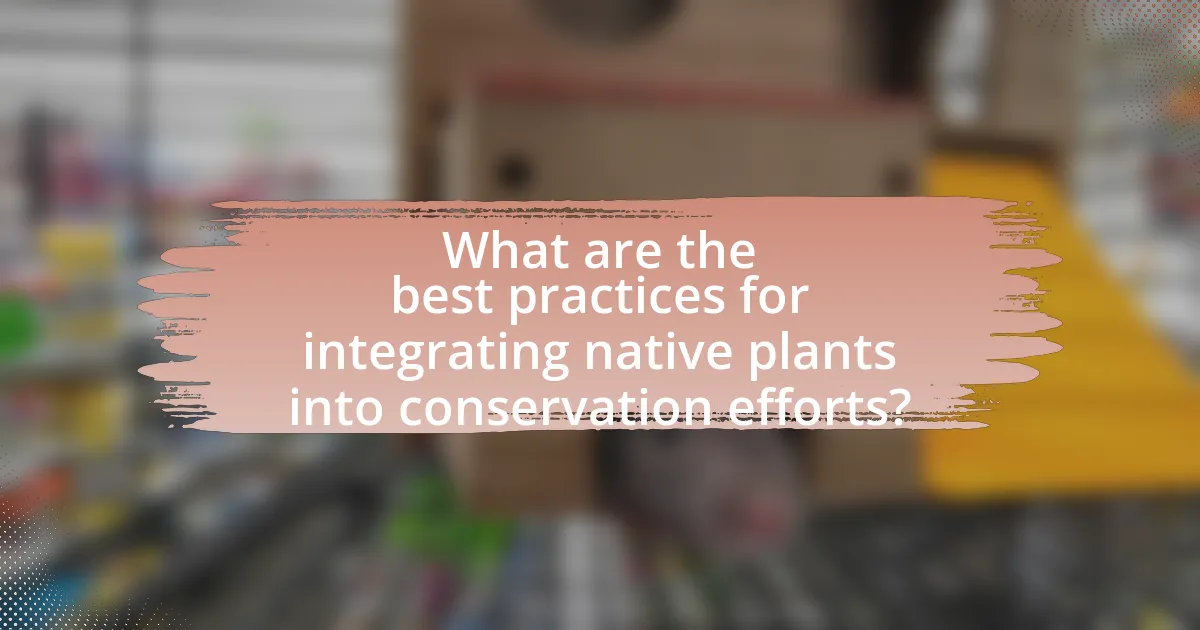
What are the best practices for integrating native plants into conservation efforts?
The best practices for integrating native plants into conservation efforts include selecting appropriate native species, creating diverse plant communities, and ensuring proper site preparation and maintenance. Selecting native species that are well-adapted to local conditions enhances ecosystem resilience and supports local wildlife, particularly insects that rely on these plants for food and habitat. Creating diverse plant communities fosters ecological interactions and increases habitat complexity, which benefits a wider range of species. Proper site preparation, such as removing invasive species and improving soil health, ensures that native plants can thrive and contribute effectively to conservation goals. Regular maintenance, including monitoring plant health and managing competition, is essential for sustaining these efforts over time. These practices are supported by research indicating that native plants significantly enhance biodiversity and ecosystem services, making them crucial for effective conservation strategies.
How can landowners incorporate native plants into their landscapes?
Landowners can incorporate native plants into their landscapes by selecting species that are indigenous to their region and integrating them into existing garden designs or creating new native plant gardens. This approach not only enhances local biodiversity but also supports insect conservation, as native plants provide essential habitats and food sources for native pollinators and other beneficial insects. Research indicates that landscapes with a higher diversity of native plants can support up to 50% more insect species compared to non-native plant landscapes, highlighting the ecological benefits of this practice.
What are the steps for creating a native plant garden?
To create a native plant garden, follow these steps: first, select a suitable location that receives adequate sunlight and has appropriate soil conditions. Next, research and choose native plant species that thrive in your region, considering factors such as local climate and soil type. After selecting the plants, prepare the garden bed by removing invasive species, weeds, and debris, then amend the soil if necessary to enhance its fertility. Plant the native species according to their specific spacing and depth requirements, ensuring to group plants with similar water and light needs. Finally, establish a maintenance routine that includes watering, mulching, and monitoring for pests, while allowing the garden to develop naturally over time. These steps are essential as native plants support local ecosystems, providing habitat and food for native insects, which are crucial for pollination and biodiversity.
How can native plants be used in restoration projects?
Native plants can be used in restoration projects to enhance biodiversity and support local ecosystems. By reintroducing native species, restoration efforts can improve habitat quality for insects and other wildlife, as these plants are adapted to local conditions and provide essential resources such as food and shelter. Research indicates that areas restored with native plants show increased insect populations, which are crucial for pollination and maintaining ecological balance. For example, a study published in the journal “Ecological Applications” found that landscapes with higher native plant diversity supported greater insect diversity, demonstrating the effectiveness of native plants in restoration initiatives.
What resources are available for those interested in native plant conservation?
Resources available for those interested in native plant conservation include organizations, educational programs, and online databases. Organizations such as the Native Plant Society and the Xerces Society provide information, workshops, and volunteer opportunities focused on native plant conservation. Educational programs offered by universities and botanical gardens often include courses on native plant ecology and conservation techniques. Additionally, online databases like the USDA PLANTS Database and the Lady Bird Johnson Wildflower Center’s Native Plant Database offer extensive information on native plant species, their habitats, and conservation status, supporting efforts to protect and restore native flora.
Where can individuals find native plant nurseries and suppliers?
Individuals can find native plant nurseries and suppliers through various resources, including local gardening clubs, botanical gardens, and online directories. Many states have specific organizations dedicated to promoting native plants, such as the Native Plant Society, which often provides lists of nurseries. Additionally, websites like the Lady Bird Johnson Wildflower Center offer searchable databases of native plant suppliers by region. These resources ensure that individuals can access a variety of native plants essential for supporting local ecosystems and insect conservation.
What organizations focus on native plant conservation and how can they help?
Organizations that focus on native plant conservation include the Native Plant Society of North America, the Center for Native Plants, and the Xerces Society for Invertebrate Conservation. These organizations help by promoting the use of native plants in landscaping, conducting research on native plant species, and advocating for policies that protect native habitats. For example, the Xerces Society works to protect pollinators by educating the public about the importance of native plants in supporting insect populations, which is crucial for ecosystem health.
What practical tips can individuals follow to support native plant species?
Individuals can support native plant species by planting native flora in their gardens and landscapes. This practice enhances local biodiversity, providing essential habitats and food sources for native insects and wildlife. Research indicates that native plants support 50% more species of butterflies and moths compared to non-native plants, which is crucial for maintaining healthy ecosystems. Additionally, individuals can participate in local conservation efforts, such as community planting events or habitat restoration projects, which directly contribute to the preservation of native plant populations. Educating others about the benefits of native plants and advocating for their use in public spaces further amplifies these efforts, fostering a greater appreciation and understanding of their ecological importance.
